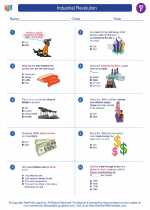Industrial Revolution
The Industrial Revolution started in Great Britain with the invention of new farming technology. In the mid 1700’s, farmers began to come up with new ideas and technology to make farming more efficient. These ideas made farming much easier and less people were needed to work the land. Read More...
◂Social Studies Worksheets and Study Guides Sixth Grade. Industrial Revolution
Study Guide Industrial Revolution
Industrial Revolution  Worksheet/Answer key
Worksheet/Answer key Industrial Revolution
Industrial Revolution  Worksheet/Answer key
Worksheet/Answer key Industrial Revolution
Industrial Revolution  Worksheet/Answer key
Worksheet/Answer key Industrial Revolution
Industrial Revolution  Worksheet/Answer key
Worksheet/Answer key Industrial Revolution
Industrial Revolution 

 Worksheet/Answer key
Worksheet/Answer key
 Worksheet/Answer key
Worksheet/Answer key
 Worksheet/Answer key
Worksheet/Answer key
 Worksheet/Answer key
Worksheet/Answer key

The resources above cover the following skills:
National Curriculum Standards for Social Studies (NCSS)
TIME, CONTINUITY, AND CHANGE
SOCIAL STUDIES PROGRAMS SHOULD INCLUDE EXPERIENCES THAT PROVIDE FOR THE STUDY OF THE PAST AND ITS LEGACY.
KNOWLEDGE - Learners will understand:
Concepts such as: chronology, causality, change, conflict, complexity, multiple perspectives, primary and secondary sources, and cause and effect.
National Center for History in Schools (NCHS)
Historical Thinking Standards
Historical Comprehension
Reconstruct the literal meaning of a historical passage.
Historical Analysis and Interpretation
Compare and contrast differing sets of ideas.
Analyze cause-and-effect relationships and multiple causation, including the importance of the individual, the influence of ideas.
United States History Content Standards
Era 4: Expansion and Reform (1801-1861)
How the industrial revolution, increasing immigration, the rapid expansion of slavery, and the westward movement changed the lives of Americans and led toward regional tensions.
The student understands how the factory system and the transportation and market revolutions shaped regional patterns of economic development.
Era 6: The Development of the Industrial United States (1870-1900)
How the rise of corporations, heavy industry, and mechanized farming transformed the American people.
The student understands the connections among industrialization, the advent of the modern corporation, and material well-being.
The student understands how agriculture, mining, and ranching were transformed.
Massive immigration after 1870 and how new social patterns, conflicts, and ideas of national unity developed amid growing cultural diversity.
The student understands how new cultural movements at different social levels affected American life.
World History Content Standards
Era 7: An Age of Revolutions, 1750-1914
The causes and consequences of the agricultural and industrial revolutions, 1700-1850.
The student understands the early industrialization and the importance of developments in England.
The student understands how industrial economies expanded and societies experienced transformations in Europe and the Atlantic basin.
Patterns of nationalism, state-building, and social reform in Europe and the Americas, 1830-1914.
The student understands the political, economic, and social transformations in the Americas in the 19th century.
Patterns of global change in the era of Western military and economic domination, 1800-1914.
The student understands connections between major developments in science and technology and the growth of industrial economy and society.
Major global trends from 1750-1914.
The student understands major global trends from 1750 to 1914.
Era 8: A Half-Century of Crisis and Achievement, 1900-1945
Reform, revolution, and social change in the world economy of the early century.
The student understands the world industrial economy emerging in the early 20th century.